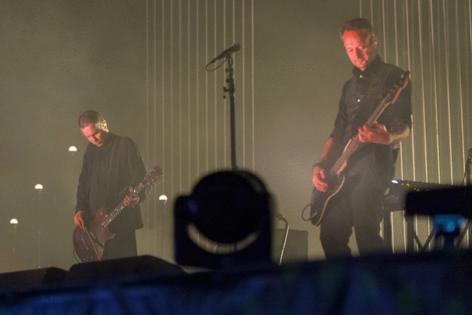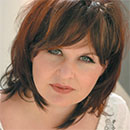Straight Outta Reykjavik! Sigur Ros chills on orchestral tour: 'We are so lucky!”
Published in Entertainment News
SAN DIEGO — The list of accomplishments by Sigur Ros, Iceland’s most successful band of all time, keeps growing, 31 years after its then-teenaged members first came together in Reykjavik.
It includes: appearances on “The Simpsons” and “Game of Thrones”; collaborations with Radiohead, famed choreographer Merce Cunningham and the Los Angeles Philharmonic; worldwide album sales of 10 million despite lyrics that are mostly in Icelandic; and performances at such storied concert venues as the Hollywood Bowl, Toronto’s Massey Hall and London’s Alexandra Palace.
“We still pinch ourselves,” said Sigur Ros bassist and co-founder Georg “Goggi” Holm. “We are so lucky and privileged to travel the world and play shows for people that want to come and see us.”
Those people are on multiple continents, as evidenced by Sigur Ros’ concert calendar from earlier this year.
Between this February and the first week of October, the band performed multiple dates in such capital cities as Tokyo, Taipei, Singapore, Sydney, Prague, Vienna, Rome, Tallinn, Brussels, Paris, London and Amsterdam.
The group’s current fall tour — which includes multiple dates in Los Angeles, San Francisco and Mexico City — is almost entirely sold out. All the performances are with a 41-piece orchestra that includes first violinist Laura Lutzke, a key member of the American Contemporary Music Ensemble and co-leader of the French orchestra Le Cercle de L’Harmonie. Each concert on the tour is being conducted by Robert Ames, the co-artistic director of the London-based Contemporary Orchestra.
“It’s been great getting to know Robert better and working with him and all these orchestras that we meet around the world,” Holm said. “It’s not always perfect, but it doesn’t matter.”
Sigur Ros’ website indicates the band will be accompanied by New York’s acclaimed Wordless Orchestra. But bringing that acclaimed New York ensemble on the road would be a costly undertaking at any time, let alone now, when touring expenses soar higher almost by the week. Instead, local regional musicians have been hired to perform under the Wordless Orchestra banner in each city on the tour.
“Everywhere we go, it’s a different orchestra,” said Holm, who does not read music. “There’s so many elements to this, so many spokes on the wheel, that it’s different every single night.”
The tour finds Sigur Ros showcasing music from 2023’s “Átta,” the group’s eighth studio album and its first since 2013’s atypically darker and more assertive “Kveikur.” The tour also features reimagined songs from the 2005 Sigur Ros album “Takk…” along with “Starálfur,” a standout song from its second album, 1999’s “Ágætis byrjun.”
A natural fit
The orchestral collaborations are a natural fit for Sigur Ros, whose often ethereal music brims with moody, slow-building crescendos and lends itself to added instrumental textures. For some fans, these concerts may well be the first time they are experiencing a live orchestral performance.
“I would definitely agree,” Holm said. “I think a lot of people come to our show and maybe expect something different than what it is, which is great. If I go to a show, I love surprises. And I think we’re using the orchestra in a different way and it’s not just this ‘post-rock band with an orchestra.’
“It’s more of a whole experience. We’re not a band with a backup orchestra. We’re playing together and doing songs differently and orchestrating them differently. We’re playing songs that we’ve not played for years in a completely different way than we’ve ever played them before.”
True to his word, when Holm and his Sigur Ros bandmates — multi-instrumentalist Kjartan Sveinsson and guitarist and singer Jón Þór “Jónsi” Birgisson — perform with an orchestra, the three musicians are not together front and center. Instead, each of them is positioned on different parts of the stage in the midst of the orchestra, the better to emphasize that all of the performers are part of a collective unit.
“Yeah, absolutely, we are integrated into the orchestra,” Holm said. “Before we started this tour, things were a little up in the air. We didn’t really know how we were gonna do this. We just started off by setting up the orchestra traditionally, and then we just squeezed in with the orchestra and we can feel it. When I’m playing, a lot of times, I’ll be looking at the cellos and I can see the brass section. Like you say, it’s not just us in the front, asking the orchestra to follow us. A lot of times, I am following the orchestra. It’s very fluid and flowy, and it can vary quite a lot.”
Holm spoke at length in a Google meeting from his home in Iceland last month.
He discussed the importance of musical mistakes (“Wrong is strong!”) and of “happy accidents.” He reflected on how thrilling it was for the young Sigur Ros to make an impact beyond its homeland. And he beamed broadly when asked about the Jimmy Lavelle-led San Diego band the Album Leaf, which opened several tours for Sigur Ros in the early 2000s (“Jimmy is a lifelong friend.”).
This interview has been edited for length and clarity.
Q: In a 2002 San Diego Union-Tribune interview, you were asked about Sigur Ros’ approach to creating music. You replied: “We go in and start playing. We do not discuss our music. We just do it. We don’t know when we’re finished. We just plug in our instruments and start playing. We just go with the flow of it and let it happen.” Now that the band is 23 years older, how similar or different is your approach to music? What has stayed the same? What has changed?
Holm: That was a long time ago! I might not use the exact same words now, but that general sort of idea still applies. We do still just walk into a room and start playing. It’s usually something where there will be a little spark of something, a riff or even a sound, that inspires us to continue working on it and create the full song out of it.
Sometimes we’ll work on something like that for a really long time, find out it just doesn’t work and we’ll leave it alone. Sometimes it happens quickly and writes itself. But we’ve never been very good at someone bringing a piece of music to the table, and saying: “Oh, I wrote this song. Let’s play it.” That doesn’t seem to be part of our approach.
Q: In 2002, Sigur Ros had been together for eight years. Were any of you then thinking music would be a lifetime career?
Holm: Good question, and a tough one to answer. I do remember that time period. A lot of things were happening. We were touring extensively. We were making records. It was a lot of work back in those days. I’m not saying there’s not a lot of work today, but now, we’ve kind of settled into it and know our limits. But did we know we were going to be doing this as a life project, or not? I think by that time, we probably did know.
I think we probably thought: “This is what we’re doing. This is our job now.” We were young and maybe we felt a little bit invincible, as you do when you’re younger. We were happy this was our job. We’ve always felt very lucky.
Q: The song “Klettur” on the most recent Sigur Ros album sounds like it could happily have gone on for 12 minutes, not 6-1/2 minutes. How did the band decide when and how the song should end? Or did it end itself, so to speak?
Holm: When we write the songs, they usually dictate themselves a little bit. They usually go in the direction they want. And we did try to steer the album in different directions as well. A lot of the songs we thought would probably end up one way ended completely different. We did a lot of experiments with putting more beats on songs. And if they wanted to be rock and roll, or if they wanted to be electronic, there’s a lot of elements we added to some of the songs that we ended up taking off.
There was a lot of layering and then taking away the layers again. A lot of the songs on this record are also songs that, as soon as we recorded orchestrations, we thought we could mute everything we played and just leave the orchestra, and the song would be beautiful that way. So, I think the songs do go where they want. But a lot of times, it takes us a long time to make them sound the way we want.
Q: To what degree does what some musicians call the “happy surprise” come into play, where you’re working on something and have an idea in mind, but the music ends up going someplace unexpected that is better than what you were going for?
Holm: That’s something that we absolutely love, the happy surprises, the happy accident, the happy mistakes. You make a mistake on a take (while recording), but it kind of sounds like it’s meant to be there. We love those things, and we tend to leave them in. We try to leave them in unless they are just stupid mistakes.
If it’s a musical mistake, it’s great. It’s a little bit like when we’re playing live, and you realize you’re making a mistake. You might be in a different spot in the song than everyone else. We call it: “Wrong and strong!” Just be wrong and strong. Just do it. Do it like it’s meant to be there. And we love that it’s absolutely a part of music.
Every time you play, it should be a unique experience. And when you do it on record, obviously you want to do it as well as you possibly can, and really, really focus. There’s a lot of mistakes on our records that no one else will actually realize are mistakes. We know they are mistakes, but they sound like they’re supposed to be there.
Q: In 2003, I interviewed a countryman of yours, Henrik Bjornson of the band Singapore Sling. He told me: “When we started, everyone in Iceland was doing post-rock, and I was really sick of it. So, all of these (expletive) post-rock bands who sound like Sigur Ros influenced me, in that I wanted to do the opposite. I guess a lot of Icelandic bands have been quite quirky, although I think that is changing.” How influential has Sigur Ros been in Iceland?
Holm: At the time, I think he was right. Henrik is definitely known for going his own way and he’s a strong character, that’s for sure. And, absolutely, there were bands in Iceland that sounded post-rock. After we started playing, there was this wave of music that sounded kind of, for lack of a better word, cute.
But we would never associate ourselves with that sort of thing. Because we like our music also to be quite dark and moody, and dusty and gritty, at the same time. We have beautiful moments, but it’s not the same as “cute.” Today, there is a lot of hip-hop in Iceland, so I don’t think there’s many bands playing today that sound like us there. But I hope we inspired bands to think that they could go further with their music than Iceland. I hope more people got that out of what we were doing than from our music itself.
Q: Two current Icelandic music artists, Laufey and Of Monsters and Men, are doing quite well internationally. But when Sigur Ros started in the mid-1990s, apart from the Sugarcubes and Bjork, there weren’t any homegrown role models you could look to. I don’t mean musically, but in terms of people who were able to have an impact beyond Iceland. How important was it to you that some artists, who lived almost around the block from you, had made an impact?
Holm: I think what Bjork did was absolutely an inspiration. And she proved you could be from a little island in the North Atlantic and do something that has so much impact. She got her music out there to so many people and did it in completely her own way, without copying anything. She stayed true to herself and that was definitely an inspiration.
When we were starting out, to go abroad and play a few shows and meet with record labels and things like that, it felt quite surreal to us. We were like: “Where is this gonna go?” But we always thought if we just stay true to ourselves and do what we enjoy doing, then it doesn’t matter how far. At the same time, it was super exciting. In 2000, we wouldn’t have dreamed we could be headlining shows around the world. One year later, we were playing in Japan! It’s been quite amazing.
©2025 The San Diego Union-Tribune. Visit sandiegouniontribune.com. Distributed by Tribune Content Agency, LLC.













Comments